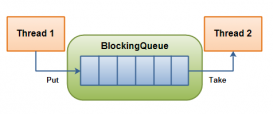java.util.concurrent包里提供了關于多線程操作的類,平常用的比較多的是ExecutorService及其實現類(如ThreadPoolExecutor等),Executor,Executors,Future,Callable等
1. ExecutorService(繼承自Executor)接口:提供了一些異步的多線程操作方法,如execute(), submit(), shutdown(), shutdownNow()等
2. Executor接口:執行提交的任務(線程),只有一個方法 execute(Runnable a)
2. Executors類: 提供了一些工廠方法和一些公共方法來操作Executor子類和ThreadFactory等,如newXXX(),xxxThreadFactory()等
3. Futrue接口:代表了線程執行結果,提供了獲取線程執行結果和取消線程的方法,如get(),cancle()等
4. Callable接口:JDK1.5提供的有返回值的線程執行新接口
對ExecutorService和Future的理解做簡單記錄
代碼:
|
1
2
3
4
5
6
7
8
9
10
11
12
13
14
15
16
17
18
19
20
21
22
23
24
25
26
27
28
29
30
31
32
33
34
35
36
37
38
39
40
41
42
43
44
45
|
public class Main { private static int count = 0; public static void main(String[] args){ List<Future> resultList = new LinkedList<>(); /** * Executors.newCachedThreadPool() 創建一個線程緩存池,若60s中線程沒有被使用,則會停止線程并從緩存池中移除 * Executors.newScheduledThreadPool() 創建一個固定容量的線程池,里邊的線程按照設定的調度時間執行 * Executors.newFixedThreadPool() 擁有固定容量的線程緩存池 * Executors.newSingleThreadExecutor() 容量為一的線程緩存池,只會有一個線程 */ ExecutorService executorService = Executors.newCachedThreadPool(); for(int i=0; i<10; i++){ Future future = executorService.submit(new Callable<String>() { @Override public String call() { try { System.out.println(Thread.currentThread().getName()); Thread.sleep(5000); } catch (InterruptedException e) { e.printStackTrace(); } int count = Main.count; System.out.println(Thread.currentThread().getName() + "..start Main count:..." + count); Main.count = ++count; System.out.println(Thread.currentThread().getName() + "..end Main count:..." + Main.count); return Thread.currentThread().getName(); } }); resultList.add(future); } executorService.shutdown(); for(Future future: resultList){ try { System.out.println(future.get() + "..is over..."); } catch (InterruptedException e) { e.printStackTrace(); } catch (ExecutionException e) { e.printStackTrace(); } } System.out.println("main thread end..."); }} |
輸出:
|
1
2
3
4
5
6
7
8
9
10
11
12
13
14
15
16
17
18
19
20
21
22
23
24
25
26
27
28
29
30
31
32
33
34
35
36
37
38
39
40
41
|
pool-1-thread-1pool-1-thread-2pool-1-thread-3pool-1-thread-4pool-1-thread-5pool-1-thread-6pool-1-thread-7pool-1-thread-8pool-1-thread-9pool-1-thread-10pool-1-thread-1..start Main count:...0pool-1-thread-2..start Main count:...0pool-1-thread-3..start Main count:...1pool-1-thread-2..end Main count:...1pool-1-thread-1..end Main count:...1pool-1-thread-3..end Main count:...2pool-1-thread-1..is over...pool-1-thread-2..is over...pool-1-thread-4..start Main count:...2pool-1-thread-3..is over...pool-1-thread-4..end Main count:...3pool-1-thread-4..is over...pool-1-thread-5..start Main count:...3pool-1-thread-5..end Main count:...4pool-1-thread-5..is over...pool-1-thread-6..start Main count:...4pool-1-thread-6..end Main count:...5pool-1-thread-6..is over...pool-1-thread-7..start Main count:...5pool-1-thread-7..end Main count:...6pool-1-thread-7..is over...pool-1-thread-8..start Main count:...6pool-1-thread-8..end Main count:...7pool-1-thread-8..is over...pool-1-thread-9..start Main count:...7pool-1-thread-9..end Main count:...8pool-1-thread-9..is over...pool-1-thread-10..start Main count:...8pool-1-thread-10..end Main count:...9pool-1-thread-10..is over...main thread end... //主線程在所有線程執行完成后結束 |
控制臺在等待5秒后打印出上邊的輸出結果,原因是所有的線程啟動的時候是一個并發操作,都會去等待5秒,所以整體看來只等了5秒,這是一個并發操作
總結:
1. ExecutorService提供的execute()方法和submit()方法的區別:
a. execute()方法只接受Runnable類型的實例,所以不能拿到返回值,也不能動態獲取線程執行的情況
b. submit()方法接受Runnable和Callable實例,會返回Future實例,Future實例的get()方法可以獲取線程執行返回值,并能拋出線程執行異常。所以如果要獲取線程執行返回的結果,并能處理線程執行時可能出現的異常,或者想中途取消線程執行時可以使用submit()方法
2. 通過輸出可以看到main方法(主線程)在所有線程執行完成后結束,原因:
a. 通過submit()方法獲取Future實例,并通過Future實例的get()方法獲取線程返回結果,而Future實例的get()方法會等待線程執行完畢才會返回,所以main方法會等待所有子線程結束才會結束
b. 若去掉上邊紅色標注的for循環,則main方法(主線程)會提前結束,而不會等待所有子線程結束
補充:
1. 多個線程并發執行時,若其中某一個線程出現了異常并且沒有被處理,則該線程會自動停止執行,但其他線程還是會正常執行,這就是為什么tomcat請求出現異常時,tomcat還可以繼續提供服務的原因。
2. tomcat提供了線程池和等待池,每一個請求過來都會重新啟動一個新的線程處理該請求,若線程池中線程用完,再來請求的時候就會放到等待池中等待,當其中有線程釋放回線程池中時,就會為等待池中的請求分配線程處理請求。
以上就是本文的全部內容,希望對大家的學習有所幫助,也希望大家多多支持服務器之家。













